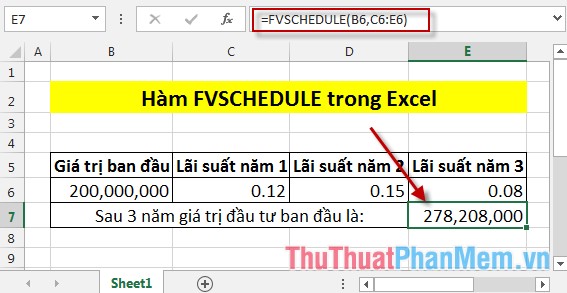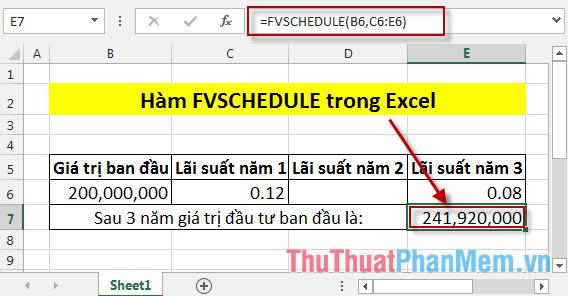FVSCHEDULE function - Returns the future value of an investment that has variable or adjustable interest in period in Excel
The following article details the meaning and usage of the FVSCHEDULE function - Returns the future value of an investment that has an interest rate that changes or can be adjusted periodically in excel.
Description: The function that calculates the future value of an investment with interest.
Syntax : = FVSCHEDULE (principal, schedule) .
Inside:
- principal : The initial value of the investment.
- schedule : an array containing the interest rates to apply.
Attention:
- The values in the array can be either numbers or blank cells, in which case the blank cell is counted as zero (interest = 0).
For example:
Calculate the amount of investment received after 3 years with an initial value of 200,000,000, knowing the interest rates for years, respectively, 0.12, 0.15, and 0.08.

In the cell to calculate the investment value after 3 years enter the formula: = FVSCHEDULE (B6, C6: E6) .

Press Enter and the result of the investment after 3 years is:

In case the interest rate value is left blank, the function of self-understanding interest rate is 0:

The above is a detailed guide on how to use the FVSCHEDULE function in Excel hoping to help you.
Good luck!
You should read it
- DURATION function - The function returns the periodic periodic interest payments in Excel
- GEOMEAN function - The function returns the average of a positive array or range of data in Excel
- AMORDEGRC function - The function returns the depreciation for each accounting period in Excel
- INTERCEPT function - The function returns the point at which the line will intersect the y-axis by using the existing x and y values in Excel
- Use the cumulative interest calculation function in Excel
- FORECAST function - The function returns a value along a linear trend in Excel
 Compare ODDFPRICE and ODDLPRICE functions in Excel
Compare ODDFPRICE and ODDLPRICE functions in Excel OR function in Excel, how to use the OR function, and examples
OR function in Excel, how to use the OR function, and examples How to get the current date in Excel
How to get the current date in Excel Group in Word, group of image blocks in Word
Group in Word, group of image blocks in Word BETADIST function - Cumulative distribution function Beta in Excel
BETADIST function - Cumulative distribution function Beta in Excel TTEST - Returns the probability associated with a Student's t-Test in Excel
TTEST - Returns the probability associated with a Student's t-Test in Excel